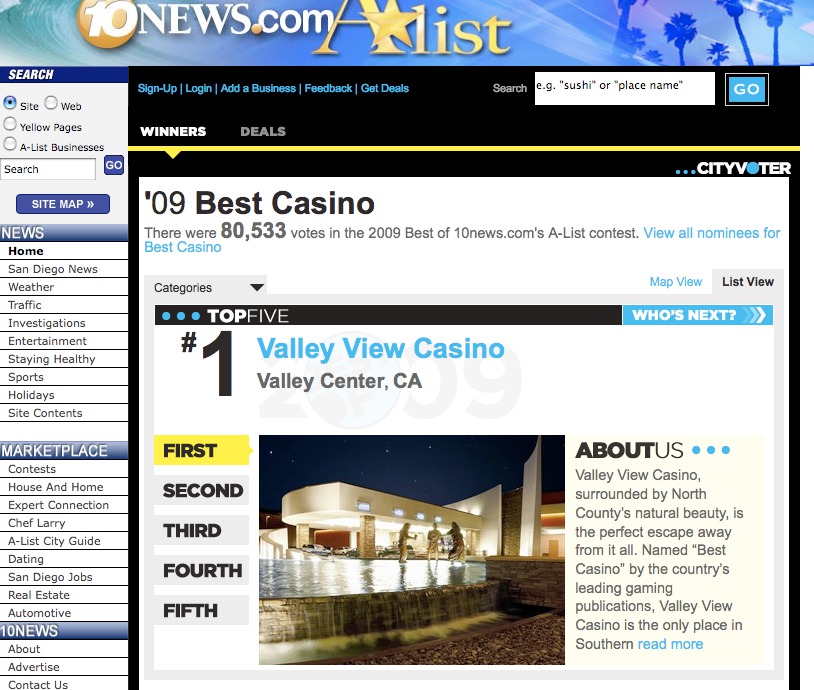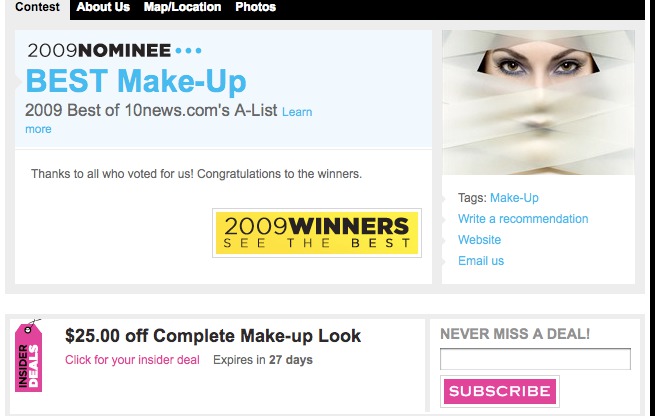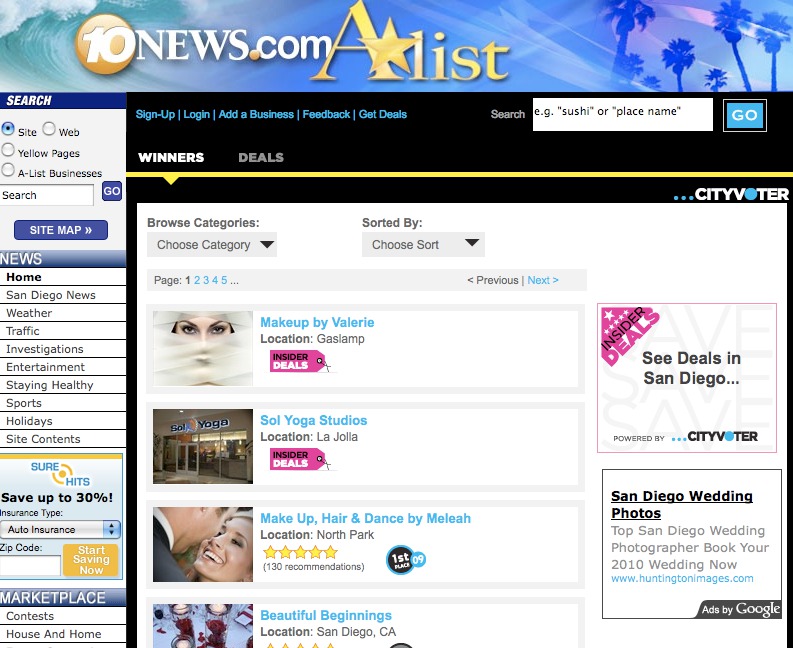Creating long term revenue from Best of Contests: How McGraw-Hill's broadcast sites gained 100 new long term advertisers
Summary: McGraw-Hill’s three television web sites needed to increase Web traffic and penetrate the local advertising market. They partnered with CityVoter.com to create the “A-List”, a version of the Best of the City contest, where consumers vote for favorite local businesses. By adding a video marketing program and data collection tools, the stations generated 100 new long term sales contracts in the first six months of 2009.
Snapshot
Company: McGraw-Hill, Inc.
Media sites: WRTV in Indianapolis, KMGH in Denver and KGTV in San Diego
Industry: Broadcast
Traffic: KGTV in San Diego, averages 650,000 unique visitors and 3.5 million page views a month
Executives: Kim Keller, McGraw-Hill Interactive and Paul Montgomery, WRTV Indiannapolis
Challenge: McGraw-Hill’s three television stations needed to achieve three strategic goals by developing:
1. More consumer content
2. A user-generated model that did not require additional investment
3. New long term small and medium sized business advertisers, in order to become less dependent on large and national advertisers.
McGraw-Hill originally partnered with CityVoter.com to create local-based entertainment and lifestyle user-guides using winners of the annual A-list contest, essentially a knock-off of Best of the City Contests. The A-List guides were based on lifestyle categories like dining, health and beauty, cheap eats and entertainment. Visitors to the site vote during and 8 week period and could leave recommendations and reviews throughout the year. Traffic to the first contest in 2006 created a moderate increase of 15% in visitors to the site, but only a one month “blip” in traffic and revenues. The station wanted to create a more robust program that would drive traffic — and give businesses a reason to advertise — all year long.
Strategy:McGraw-Hill executives created a Video Marketing Program that up-sold A-list winners and nominees to annual contracts. The program has several components:
A. Creation of videos for A-List winners and nominees that “look” like content not advertising. “We used internal videographers from the television station and to keep the costs down we didn’t do lighting, make-up or scripting. We just went out and had a conversation with the advertiser,” says Keller. Prior to shooting the station sends the merchant 10 to 20 questions to think about. “So when we went out we could fire questions like, ‘tell us about your business, how did you get started?’ the merchant would be prepared and talk naturally.”
Production staff then edits out the questions so the spots looked like natural free flowing video and the merchant’s “passion for their business comes through.”
“We have video of their famous cocktail and how to make it yourself or what is in the secret sauce,” Keller says. “We want it to be informative, entertaining and specifically did not want it to look like a commercial.” The videographer even uses a shoulder-cam to create shots that look “believable”.
“Commercials aren’t believable, they are scripted, stiff and phoney. We wanted the spots to be internet savyy, so the small business’s passion and commitment come out.” The station charged just $495 to set up the video, which barely cover costs, but made money from the additional marketing components.
B. Promotion campaigns generate traffic to the videos
The station relied on a number of innovative marketing campaigns to boost traffic, and therefore advertiser response:
*Videos placed on landing pages on the CityVoter site.
These landing pages are simply part of the CityVoter directory of winners. “Some advertisers showing up on page ten or 12 of the search results jumped to page one or two within 90 days after posting the videos.”
*Videos syndicated across search and other media platforms
The station uses a free service called TubeMogul to upload video and populate YouTube, Google, MySpace and Yahoo with the videos. Video pages jump to Number one in search engine video requests.
*Register to win” data-collection programs for merchants
The television stations created “Register to Win” contests that offered prizes, such as dinner for two, from merchants who pay for the data-collection lists that include name, address, phone number and email. “Register to Win” contests also have an “opt-in” check off that allows users to choose ” yes send me additional offers”. Besides banner promotions, a widget developed by a sub-contracting developer contains all 30 A-List “Register to win” contests on the home page of the site.
The “Register to win” contests also run on air all year long. “Before we could only promote the voting period. By having video (”Learn more about your favorite restaurants”) and on-going contests, we could promote all year long,” Keller said.
C. Video Widget “A-list TV”
A widget called A-List TV on the front of the site lets viewers see the videos, and click to get a coupon or access other offers.
D.Creation of a “Manager of Results” executive position.
A new role in the company, Manager of Results, responsible for all three markets makes sure advertising campaigns are out-performing expecatations and that advertisers are happy with their results.
Results: The A-List contest resulted in about 100,000 voters during the eight week period, and 2 million new visitors. The video marketing program resulted in an increase in traffic of 38% year -to-year from 2008 to 2009. Each site now has generated an average of 33 new small business advertisers so far this year, for a total about about 100 for the three stations. While the program is only six months old, statistics already show an increase in revenues of $5000 a month per station. Sales reps are averaging 3.8 sales a week from their A-list winners, with an average annual sale of $2200 per customer. Each rep is on track to bill or $434,000 in new revenues. The program which launched last year in Denver has a 92% retention rate.
One success story is “Win a Royal dinner of Two” campaign from an A-list winner (see landing page at http://www.10news.com/sponsors/18517930/detail.html) which generated 800 entries per month and 60% of entrants are opting-in for other permission based marketing. These lists are co-owned by the stations, who are positioned to take advantage of future iPhone applications, location marketing and twitter notifications.
Lessons learned:
*”Make sure that the programs are working from the customers point of view, not yours.”
*Establish the expected ROI early on by asking advertisers in advance what they perceive is the monetary value of names collected.
*Price the programs in the small business range; $300 a month was the sweet spot, and focus on year long programs.
*When data collection outperforms client expectations, plan on moving to to CPL basis.

The author, Alisa Cromer is publisher of a variety of online media, including LocalMediaInsider and MediaExecsTech, developed while on a fellowship with the Reynolds Journalism Institute and which has evolved into a leading marketing company for media technology start-ups. In 2017 she founded Worldstir.com, an online magazine, to showcases perspectives from around the world on new topic each month, translated from and to the top five languages in the world.















